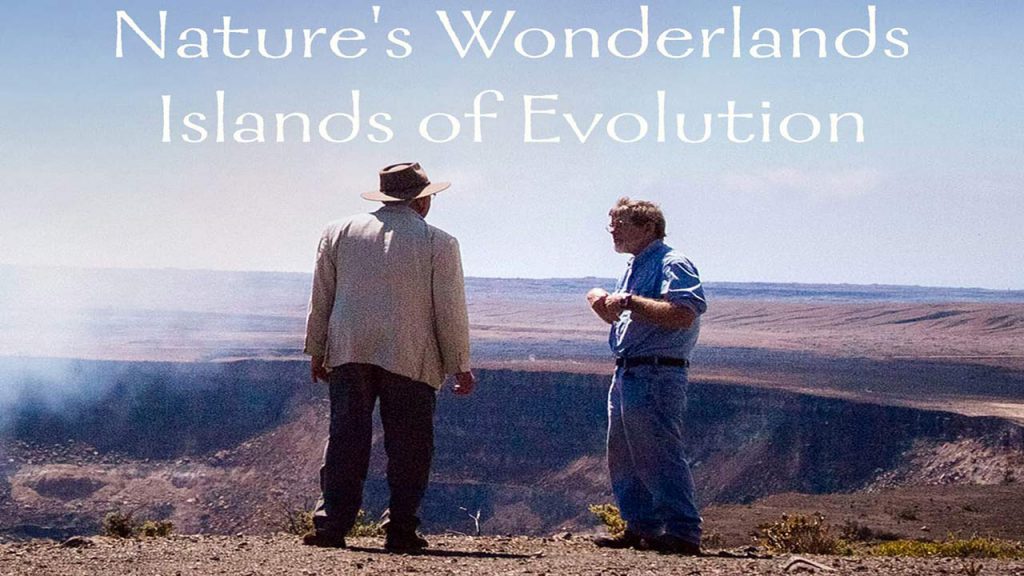Islands of Evolution episode 1 – Hawaii: Richard Fortey investigates why islands are laboratories of evolution. On Hawaii he finds honeycreeper birds, carnivorous caterpillars and silversword plants. In the first episode, Fortey is on Hawaii to investigate how life colonises a newly born island. According to some estimates, Hawaii has been successfully colonised by only one new species every 35,000 years due to its remote location – yet the Hawaiian Islands teem with a great diversity of life. In search of the evolutionary secrets of how one species becomes many, Fortey encounters beautiful honeycreeper birds whose evolution rivals that of Darwin’s famous finches; carnivorous caterpillars who now can’t eat leaves, and giant silversword plants that thrive in parched volcanic soil at 10,000 feet.
Three-part series in which Professor Richard Fortey investigates why islands are natural laboratories of evolution and meets some of the unique and remarkable species that live on them. Examining some of the crucial influences on natural selection that are normally overlooked – like geology, geography, isolation and time – the series reveals that there is much more to evolution than ‘survival of the fittest’. Charting the lifecycle of islands – from their birth and colonisation to the flowering of evolutionary creativity that often accompanies their maturity, and what happens when an island grows old and nears its end – Fortey encounters wild lemurs in the rainforest of Madagascar, acid-resistant shrimps in the rock pools of Hawaii, and giant wolf spiders in Madeira as he searches for the hidden rules of island evolution.
Islands of Evolution episode 1 – Hawaii
Hawaii is an archipelago of volcanic islands in the central Pacific Ocean, and it is a prime example of the process of evolution. The islands are a natural laboratory for scientists to study how species evolve and adapt to new environments. In this essay, we will delve into the unique features of Hawaii’s ecosystems and the ways in which they have shaped the evolution of its flora and fauna.
First, let’s consider the geography of Hawaii. The islands are isolated from the mainland, making it difficult for species to migrate from one island to another. This isolation has allowed for the development of unique and diverse ecosystems on each island. For example, the lush, tropical forests of the big island of Hawaii are home to a wide range of plant species, many of which are found nowhere else in the world.
Next, let’s examine the ways in which the species in Hawaii have adapted to their environment. The plants and animals that call Hawaii home have evolved unique adaptations to deal with the challenges posed by the islands’ unique geography and climate. For example, the nectar of many Hawaiian plants is particularly rich, which attracts a variety of pollinators, including honeycreepers, a group of birds that are found only in Hawaii. Another key factor in the evolution of Hawaiian species is the presence of active volcanoes on the big island. Over time, the volcanic activity has created new land, providing new habitats for species to colonize. This process is called “secondary succession,” and it has allowed species to evolve and adapt in response to changes in their environment.
Moving on, let’s examine the impact of human activity on the ecosystems of Hawaii. The arrival of humans on the islands has brought about significant changes, including the introduction of new species, habitat destruction, and changes to the landscape. For example, many native bird species have been pushed to the brink of extinction due to the introduction of non-native predators, such as rats and mongooses. Despite these challenges, scientists are working to protect and preserve the unique ecosystems of Hawaii and the species that call them home.
Hawaii is a prime example of the process of evolution, with its diverse ecosystems and unique flora and fauna providing a natural laboratory for scientists to study the ways in which species evolve and adapt to new environments. From volcanic activity to human impact, the islands of Hawaii offer a glimpse into the complex interplay of factors that shape the course of evolution.




